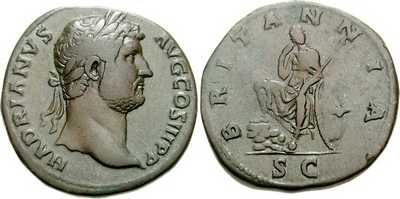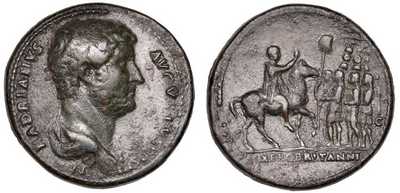| Back to Vespasian and Titus | This page is part of the article Roman Coins About Britain | Forward to Antoninus |
The next appearance of Britain on Roman coins occurred in 119 AD when Hadrian issued two bronze Asses with Britannia on them. The goddess Britannia was the female personification of the island of Britain, and this was her first appearance on coins (but not her last. She still appears on British coins almost 2,000 years later). Both coins (RIC 2 577a and RIC 2 577b) are pretty much identical, with the only difference being some drapery on Hadrian’s shoulder.
It’s not clear why Hadrian issued coins with Britannia on them at this time, and three different reasons for these coins are often given.
- Hadrian is of course famous for the wall he built across the north of England to protect the northern most boundary of the Roman empire, and that’s something we might expect to see celebrated on coins, but construction of the wall didn’t begin until 122 AD, several years after the coins were minted.
- Hadrian is also famous for travelling around the Roman empire and minting coins celebrating all of the places he visited. His first trip was from 121-125 AD, where he visited Britannia, Hispania, North Africa, and Athens. But again, this post-dates the coins, and despite visiting all of these places, only coins mentioning Britannia were minted in this timescale. All of his other “travel” coins were minted at the end of his reign.
- Historical (but not contemporary) sources hint at some kind of military victory in Britain at some stage of Hadrian’s reign, and these coins are sometimes said to celebrate Hadrian’s victory over the British. However, details about this are vague and the coins themselves are used as evidence for it and to date it to the start of his reign (if it happened at all). There are two problems with this. Firstly, Britannia is armed with a spear and unbound, which she wouldn’t be on a standard “capta” coin. Conquered natives on “capta” coins are bound and unarmed. Secondly, these coins are almost exclusively found in Britain, suggesting they were minted for the British market. It’s unheard of for the Romans to celebrate a victory only in the province where it occurred. Chapter 10 of “The Roman Invasion of Britain: Archaeology versus History” by Birgitta Hoffmann has much more detail on this.
Britain reappeared on a selection of coins minted between 134 and 136 AD when Hadrian was nearing the end of his life. Four sets of coins were minted to celebrate the achievements of his reign. These were:
- Provinces of the Roman empire in female form
- An “Adventus” series which shows the arrival of Hadrian in various provinces
- An “Exercitus” series which celebrated armies of the empire
- A “Restitutor” series which showed Hadrian as “restorer” extending his hand to raise to her feet the province kneeling before him
Restitutor Type
Britain is missing from the Restitutor set for some reason, but based on the very low survival rates of the “arrival” and “armies” coins, it’s likely that the coins did once exist but just haven’t survived.
Provinces Types
The “Provinces” coins are the most common of the types, and the Asses can sometimes be picked up relatively cheaply, although that depends a lot on condition. The sestertius and dupondius versions are rare (CNG say “…with about 10 dupondii and six sestertii known) and expensive as a result.
| Sestertius | Dupondius | As |
|---|---|---|
| RIC 2 845 | RIC 2 846c | RIC 2 846c |
| RIC 2 846f | RIC 2 846f |
Exercitus Types
The “Exercitus” types (sestertius; two different reverses) are rare, but they do occasionally turn up for sale. The first type with Hadrian on a horse appears to be the rarer of the two.
Adventus Type
The “Adventus” type (sestertius) is so rare that the best I could find was a line drawing and an unattributed photograph. This site says there are only one or two genuine examples known.
The photo is rare online, and is unattributed on all sites and documents that have it.
The line drawing is from Akerman’s 1844 book “Coins of the Romans Relating to Britain”
Article Navigation
| Back to Vespasian and Titus | Up to Roman Coins About Britain | Forward to Antoninus |







